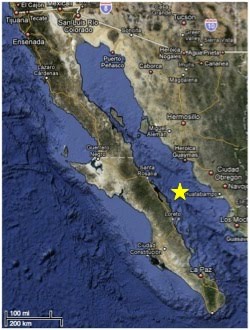Much of our focus on thermoacidophiles at deep-sea hydrothermal vents has centered on an archaeal lineage known as the deep-sea hydrothermal vent Euryarchaeaota group-2 (DHVE2) as they were the first obligate acidophiles described from these environments. The first cultivated organism within the DHVE2, Aciduliprofundum boonei, was originally isolated from the Eastern Lau Spreading Center in 2006. Since then, we have cultured more representatives from the Mid-Atlantic Ridge, East Pacific Rise and again from Lau (see figure below). Cultivation of these new isolates continues to demonstrate the peptide scavenging lifestyle of the DHVE2 and is beginning to show some biogeographic patterns with respect to 16S rRNA gene diversity. Culture independent techniques, such as high-throughput pyrosequencing, are also beginning to show correlations between the type of vent feature and the presence of the DHVE2.
 Neighbor joining tree of cultured representatives of the DHVE2 based on 1261 unambiguously aligned nucleotides of 16S rRNA gene sequences. Scale bar represents 10 substitutions per 100 nucleotides.
Neighbor joining tree of cultured representatives of the DHVE2 based on 1261 unambiguously aligned nucleotides of 16S rRNA gene sequences. Scale bar represents 10 substitutions per 100 nucleotides.
On our current cruise, we have been using quantitative-PCR (QPCR) to determine if the DHVE2 are present in vent deposits from the Guaymas Basin. Surprisingly, preliminary results have demonstrated the presence of these thermoacidophiles despite the higher pH of the Guaymas fluids. Below is a photo of a vent deposit collected during this cruise where the DHVE2 have been detected by QPCR.
Lauri’s Guaymas Impressions:
14 November: The Bridge is the tidiest place I’ve seen on Atlantis, although now I have a much better understanding of the term ‘ship shape’. It’s bright, shiny, and loaded with sophisticated technology surrounded by a panorama of windows. Chief Mate Peter Leonard recently explained the basics of the ship’s control and navigation systems to me as I stared in wonder. Thanks to an array different GPS technologies, some linked with the ship’s thruster controls, Atlantis can automatically remain within nine feet of a desired heading even in rough seas.

Computers and software have greatly enhanced navigation safety as well. Now most ocean going vessels are required to input their course and ship information into a system that makes the data available for other ships to see, thus enabling safe navigation especially in low visibility. But there is still some old-school equipment in use, my favorite being the wooden heading indicator from the original Atlantis called “the blocks”.





No comments:
Post a Comment